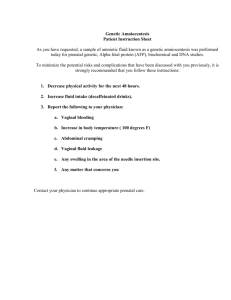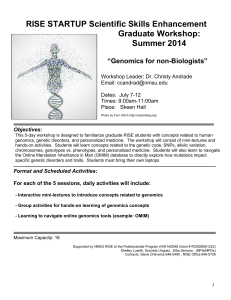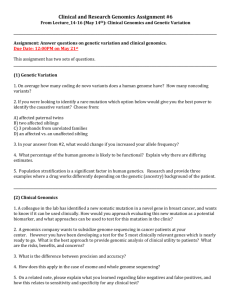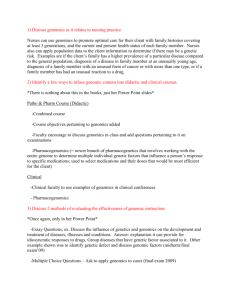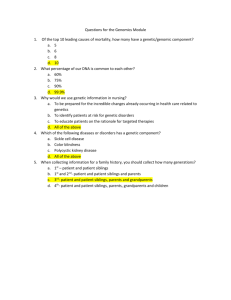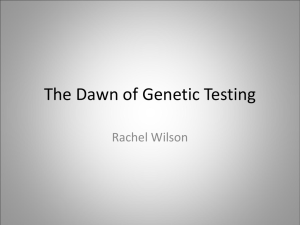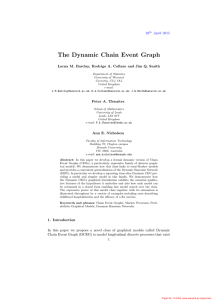Developement and Pilot testing of a Web
advertisement
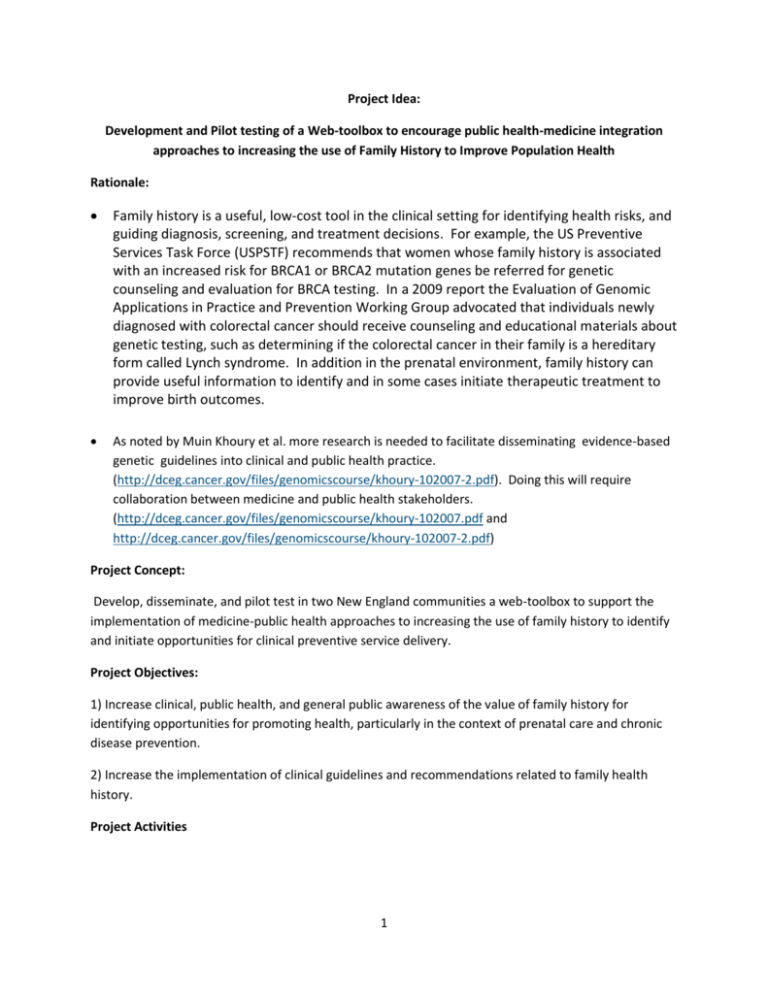
Project Idea: Development and Pilot testing of a Web-toolbox to encourage public health-medicine integration approaches to increasing the use of Family History to Improve Population Health Rationale: Family history is a useful, low-cost tool in the clinical setting for identifying health risks, and guiding diagnosis, screening, and treatment decisions. For example, the US Preventive Services Task Force (USPSTF) recommends that women whose family history is associated with an increased risk for BRCA1 or BRCA2 mutation genes be referred for genetic counseling and evaluation for BRCA testing. In a 2009 report the Evaluation of Genomic Applications in Practice and Prevention Working Group advocated that individuals newly diagnosed with colorectal cancer should receive counseling and educational materials about genetic testing, such as determining if the colorectal cancer in their family is a hereditary form called Lynch syndrome. In addition in the prenatal environment, family history can provide useful information to identify and in some cases initiate therapeutic treatment to improve birth outcomes. As noted by Muin Khoury et al. more research is needed to facilitate disseminating evidence-based genetic guidelines into clinical and public health practice. (http://dceg.cancer.gov/files/genomicscourse/khoury-102007-2.pdf). Doing this will require collaboration between medicine and public health stakeholders. (http://dceg.cancer.gov/files/genomicscourse/khoury-102007.pdf and http://dceg.cancer.gov/files/genomicscourse/khoury-102007-2.pdf) Project Concept: Develop, disseminate, and pilot test in two New England communities a web-toolbox to support the implementation of medicine-public health approaches to increasing the use of family history to identify and initiate opportunities for clinical preventive service delivery. Project Objectives: 1) Increase clinical, public health, and general public awareness of the value of family history for identifying opportunities for promoting health, particularly in the context of prenatal care and chronic disease prevention. 2) Increase the implementation of clinical guidelines and recommendations related to family health history. Project Activities 1 1. Develop and disseminate a web portal that links to existing or newly created (see below) resources to support clinical (primary care), public health, and general public awareness about the value and use of family history in the prenatal and chronic disease settings. 2. Develop and conduct a mini-grant opportunity for two New England communities implement a collaborative medicine-public health project using the information and tools contained in the portal. Web Portal Overview (just ideas, nothing “written in stone” Provider section: contain tools such as: o Tools being created by Bev Burke etal. in CT to increase provider awareness about inherited breast and colon cancer. packets being built by CT with their HP2020 to educate providers, The recorded grand round presentation about guidelines for “on prevention and early detection of cancer and the appropriate use of genetics counseling services and tests” o o NEW PRODUCT: take the GR presentation and tailor it to create 15 minute podcasts that provide another avenue to get info out in a shorter increments Genetic Alliance: Family history brochures that could be tailored Family History for the Prenatal Provider Project: Grand Round Curriculum Public Health Section: o Create a presentation (or maybe a video??) about the value of Family History in improving public health (Building off of Sudden Cardiac Death of the Young video from MI, Family History in the Prenatal Care Setting Curriculum, NERGG PHG Taskforce Family History Curriculum) o Links to Provider section about inherited breast and colon cancer. o NEW: Develop health promotion tools (Youtube video tailored to New England audiences) for general public & clinicians about the value of family history (look at existing tools and see if they are ideas that could be used for example – the Family history and chronic disease cards and/or posters created by Michigan as a model to develop ones tailored to New England?) o Links to PH Genomics e-news alerts created by NERGG PHG Taskforce General Public Section o Links to CDC Family Health Portrait website o Links to public awareness tools in the PH Practitioner section Integration Section: Provide tools and best practice ideas for how to link medical and public health stakeholders together to improve population health. For example, “Medical Care and Public Health System Integration: A Practical Guide and other integration tools contained on the Citizens Health Initiative Website. Dessemination 2 Short video “infomercial” about the webportal that could be “pushed” through appropriate channels (PH Associations, State PH Offices, Medical Societies, Nursing Associations) Feature the resources on NEGC Website/newsletter and NERGG PHG Genomics e-news alerts. Conduct presentation about the portal at State & regional chronic disease and maternal and child health meetings. Conduct class lectures/seminars at clinical and public health graduate and undergraduate PH programs throughout New England. Other innovative ideas?? Smart phone app push? Pilot Test Competitive mini-grant ($5-10,000) Program: Two NE communities would receive awards to use portal tools to conduct a clinical-public health campaign in their community to promote the adoption of clinical guidelines based on family health history. Possibly require a 50% matching requirement? Operationalizing (again, thoughts not written in stone) DEM (augmented by inviting those from NERGG’s PH Genomics Taskforce) Group: Develop webportal and new tools needed for tools. NEGC Admin.: overseeing mini-grant RFP and process Benefits of this idea Builds off the following RC Program Priorities: 1) Treat in the context of a medical home that provides accessible, family-centered continuous, comprehensive, coordinated, compassionate, and culturally effective care. i. a. Strive to provide, translate and integrate the family history tool for genetic and treatable chronic conditions (for example, diabetes, coronary artery disease), newborn screening information and follow-up practice including just-in-time resources (HRSA/NCC ACTion sheets), genetic medicine, genomic information, and evidence-based clinical guidelines. 2) Expand the pool of the genetic service workforce by determining needs and gaps across sectors to provide education and training, with emphasis on allied health providers, other subspecialties and educators. Examples are: ii. a. Nurses (home visiting nurses, nurse practitioners, nurse midwives, doulas and other childbirth educators). iii. b. Faculty and students at school-based systems and health care centers. 3) Strengthen public-private partnerships, communication and collaboration among public health, individuals and their families, primary care providers, and genetic medicine, other subspecialty providers, and other entities. Builds off of existing tools already financed by HRSA and CDC (for example tools being developed by CT, Family Hx for Prenatal Providers GR Curriculum) Potentially a great next project for DEM group 3 Continues to build connection to NERGG PH Genomics group Addresses HP 2020 objectives related to PH Genomics Required resources Resources for DEM group to work on this Mini-grant funds $ for video/podcast development $ for webportal development Admin. time 4
